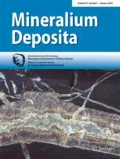Abstract
The French Massif Central (FMC) represents the whole West European Variscan (WEV) belt, in terms of both the geodynamic evolution and the metallic content. Thus, a study of the metallogenic evolution of the FMC may elucidate the conditions that allow the mineralisation of a collision belt, since recent collision belts, e.g. the Himalayas or the Alps show that mineralisation does not necessarily result from the collision process. The Palaeozoic history of the FMC is divided into three geodynamic stages unevenly involved from the metallogenic view point. The Eo-Variscan stage (Cambrian to Silurian) was not important; the Meso-Variscan stage (Devonian-Early Carboniferous) was of limited importance; and most of the mineralisations formed during the Neo-Variscan stage (Late Carboniferous-Early Permian). In addition, some more mineralisation was produced during the Mesozoic because of the thermal reactivation linked with the Alpine orogenies.
The Eo-Variscan stage (Cambrian-Silurian) corresponded to the pre-collision history, marked at the WEV belt scale by a fragmentation of the northern Gondwana (immature crust evolved from the Late Proterozoic Cadomian orogeny), up to the break-up of the crust and the formation of oceanic basins (Cambrian-Ordovician), followed by their resorption by subduction during the Silurian. In the FMC, no subduction-related magmatism is known (being rare at the WEV belt scale), and consequently subduction-related mineralisation, e.g. porphyry copper, is unknown in the WEV belt. Although some ophiolitic remnants are known, they never display Cyprus-type VMS deposits, nor massive podiform chromitites. Beside platformal sedimentary deposits on passive margins, the only deposits formed during the Eo-Variscan stage were of the SEDEX type, linked with the early rifting of the Gondwanian crust.
The Meso-Variscan stage (Devonian-Early Carboniferous) corresponded to the collision proper, with the formation of crustal-scale nappe structures and the intrusion of collision-related peraluminous granites. Although these granites were enriched in rare metals they did not yield significant hydrothermal mineralisation, due to the great depth of their emplacement, as the similar granites in the Himalayas. However, they were a source of rare metals (in particular, uranium) for later mineralisation events. At the WEV belt scale Devonian distensive events are coeval with the collision. They were recorded by the formation of sedimentary basins of limited time and space extent, corresponding to the splitting of the continental crust (up to formation of oceanic domains in many cases), and were characterised by a bi-modal (“spilite-keratophyre”) volcanism. These basins formed in transtensional (or pull-apart) settings along major strike-slip faults, a peculiarity of the Variscan collision belt (which may conveniently be described as a “strike-slip orogen”). In such basins, many deposits linked with the volcanic thermal energy were formed: SEDEX deposits of the Meggen-type, iron deposits of the Lahn-Dill-type and VMS base metal deposits, the latter being the only ones known in the FMC (Brévenne deposits).
The Neo-Variscan stage corresponded to the “hypercollision” and was characterised by a shift from compressional tectonics (late thickening of the crust during the Sudetian event and long-lasting dextral strike-slip tectonics along NW-SE to NE-SW fault zones) towards extensional tectonics (“basin and range” of the Late Stephanian-Early Permian), as well as by high heat flows, recorded by LP-HT metamorphism, extensive granitisation and granulitisation of the lower crust. These characteristics record the development of a lithospheric delamination process. In response to the energetic input released by this process, numerous hydrothermal deposits were formed in the FMC, as well as in the whole WEV belt, during the Neo-Variscan stage. These are mainly: (1) high-temperature granite-centered tungsten deposits, mainly associated with cordierite-bearing high level intrusions of Namurian-Westphalian age; (2) rare metal granites (and the associated hydrothermal tin mineralisations), resulting from fluid-induced low-degree partial melting of the middle crust in relation with the devolatilisation of the granulitised lower crust; (3) shear-zone hosted gold and antimony deposits, related to crustal-scale hydrothermal circulation, triggered by the transition to extensional tectonics at about 300 Ma; and (4) uranium deposition in extensional settings related to the Early Permian distension.
The Post-Variscan mineralising events recorded the renewal of thermal flows in the lithosphere linked with early Alpine events (mainly the Trias-Lias distension in the Tethyan realm and the middle Cretaceous opening of the Bay of Biscay in the Pyrenean realm). They resulted in low-enthalpy geothermal systems, leading to a variety of deposits, mainly: (1) F-Ba districts, reworking F and Ba from Late Variscan granites and ignimbrites; (2) a major uranium deposit (Lodève), reworking uranium from the Permian Lodève basin; and (3) Zn-Pb districts of the MVT-type.
Finally, the mineralisation of the Variscan collision belt is mainly the consequence of the Neo-Variscan lithospheric delamination process. By contrast, the absence of such a process in collision belts like the Himalayas or the Alps is the key of them being devoid of mineralisation. It appears that the mechanical energy released by the collision itself is not sufficient to mobilise and concentrate the trace elements involved in the metallogenic processes.
Similar content being viewed by others
Author information
Authors and Affiliations
Additional information
Received: 1 September 1998 / Accepted: 3 February 1999
Rights and permissions
About this article
Cite this article
Marignac, C., Cuney, M. Ore deposits of the French Massif Central: insight into the metallogenesis of the Variscan collision belt. Mineral. Deposita 34, 472–504 (1999). https://doi.org/10.1007/s001260050216
Issue Date:
DOI: https://doi.org/10.1007/s001260050216




